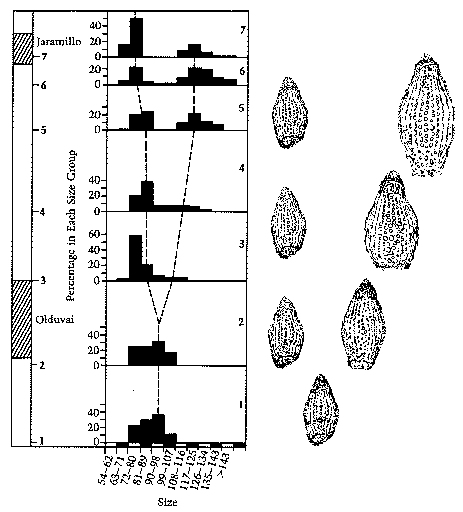
A Radiolarian is a single-celled plankton. The diagram shows a new and larger species, Eucyrtidium matuyamai, slowly branching off from the species Eucyrtidium calvertense. Pictures of both species are shown on the right hand side, greatly enlarged.
As is usual in geology, the diagram gives the data for the deepest (oldest) fossils at the bottom, and the upper (youngest) fossils at the top. Sample one is from two million years ago, and sample seven is from one million years ago.
The black histograms show the sizes of the fossils at seven different depths. A histogram is used to show the fact that the fossils are not all exactly the same size. The horizontal scale was chosen so that there were ten different size groups. The numbers such as "20" and "40" are the scales for showing the percentages that fell in each size group.
For samples one and two, the histograms show that there was initially a single species, with not much variation. By sample three, the variation has increased. By samples five and six, the fossils are clearly falling into two groups, although there are still fossils of intermediate size. In sample seven, there are no longer intermediates, and the original species has now split into two species.
Radiolarians are small, one-celled drifting (nektonic) plankton with silica-based "skeletons" (tests). The fossils in the diagram were found in deep-sea drill cores from the northern Pacific.
The species at the top left of the diagram is considered to be the original species, rather than a new species. As you can see, the size has changed a little, but the difference does not have enough statistical significance.
The core was dated by checking the orientation of the magnetic materials in the sample. The pattern of reversals was then correlated to the reversals of the Earth's magnetic field which are known from elsewhere. The striped regions on the left of the diagram show the regions of the core that correspond to the Jaramillo and Olduvai reversals. This places the core as part of the Pleistocene. The Jaramillo lasted about 70,000 years. The Olduvai lasted about 200,000 years, starting 1.87 million years ago.
The diagram is from
Prothero, D.R. and D.B. Lazarus, 1980 Planktonic microfossils and the recognition of ancestors. Systematic Zoology, 29: 119-129.and a recent description of the magnetic reversal scale is
Harland, W.B.; Armstrong, R.L.; et al., 1990. A Geologic Time Scale, 1989. Cambridge University Press: Cambridge, p.1-263. ISBN 0-521-38361-7.